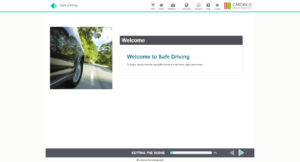A new online e-learning course that builds a plan around an employee’s responses to a driving risk assessment.
Our new and improved Safe Driving course is an online driver risk assessment and e-learning course. It builds on our previous program and is a more engaging and effective form of preliminary driver risk assessment.
This e-learning course provides sound, educational content – focusing on core driver risk areas such as making sure a vehicle is safe and legal, common types of collisions, speed and lone working.
The content in the course is backed up by a risk assessment and action pan. This course provides a simple and easy-to-use solution for measuring organisational risk for end users. It has a set of activities which is designed to help make employees make safer choices and reduce injuries when driving.
What are my responsibilities, as an employer?
Driving is one of the greatest risks we all face – as drivers, riders, passengers and pedestrians we are all exposed to road risk daily, whether we recognise it or not.
The Health & Safety at Work etc Act 1974 requires that employers “so far as reasonably practicable, to ensure the safety health and well-being of others” – this includes managing the risks of employees on the road.
More than 95% of collisions are totally or primarily due to actions a driver took – or failed to take. The driver is the key risk factor to examine (although don’t neglect the aspects of unroadworthy vehicles or use of the wrong vehicle and journey risks).
Employers must carry out “suitable and sufficient risk assessments” to identify all risks a driver might face on the road. This means employers must assess drivers and identify high-risk drivers who are more likely to crash. Crashes can be costly to a business, so reducing the risk of them is not only in the interest of safety – but is also a smart business choice.
Our e-learning course, with risk assessments, is an excellent way to provide a preliminary basis for identifying risk and increasing driver safety. Our course does not replace in-vehicle training, risk audits or fleet risk measures – but it does create a strong basis for identifying areas of risk and giving drivers training which can help them drive safely.
What is the benefit of a driver risk assessment?
Everyone is aware of the need to apply good health and safety principles when at work, but most of the time, risks are static – and therefore, easily preventable. For example, a guard can easily be added to machinery and exit signs can be put up to identify emergency routes.
However, in a driving situation – the potential risks are continually changing. Road conditions, weather and other people’s actions all play a role in the likelihood of a driver being involved in an accident. An online driver risk assessment can provide a valuable piece of intelligence for both an employer and the driver – minimising the exposure to risks and helping to promote safer driving.
What is a driver risk assessment?
A driver risk assessment focuses on several key areas:
- Driver risk
- Journey risk
- Vehicle risk
- Vehicle maintenance
- Driving comfortably
Typically, a risk assessment addresses everyday issues and provides a profile of the type of driver and vehicle owner an employee may be. An assessment might ask how often a driver checks tyre pressure, what a vehicle is used for or how long an employee drives on a typical business day. These factors, when put together, create a report which highlights levels of driver risk. Aggregated data of this type is important for employers in assessing areas where they can plug gaps, issue further training, or ensure policies are communicated. For the individual, it provides a roadmap for risk reduction. Next – we move on to action plans.
What is ‘My Action Plan’?
‘My Action Plan’ provides a step-by-step process for reducing or eliminating driver risks. It is based on the individual’s responses from the driver risk assessment and provides recommendations on how to act on results, with solutions for the potential risks identified.
For example, if you answer that you failed to take adequate breaks when driving long distances, it might tell you that it is important to take 15-minute breaks, every 2 hours.
When the action is resolved, the driver can complete the task on the action plan, and this will solve the risk. In future, the driver may retake the risk assessment and it may provide a different answer. This could bring the action back into the plan but offers a useful tool for reinforcing learning.
E-Learning an Effective tool for Driver Risk
 E-learning is a cost-effective way to assess and train drivers. Online courses have helped thousands of organisations and drivers gain a greater understanding of driver risks, road conditions, vehicle maintenance, hazards and driver health beyond the traditional testing environment in the UK.
E-learning is a cost-effective way to assess and train drivers. Online courses have helped thousands of organisations and drivers gain a greater understanding of driver risks, road conditions, vehicle maintenance, hazards and driver health beyond the traditional testing environment in the UK.
It is a manageable and measurable way to communicate safe driving to employees and has helped to show a managerial and corporate commitment to driver health and safety. While accidents cannot be wholly prevented, there is a lot an employer can do to support drivers in finishing journeys safely, and e-learning can be an essential part of that mix.



